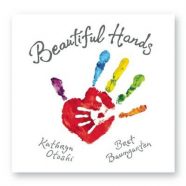Celebrate all the BEAUTIFUL HANDS!
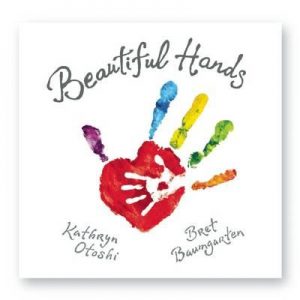 August is crazy-busy for teachers and parents of little learners, so grab this book for a quick-prep, interactive lesson: BEAUTIFUL HANDS by Kathryn Otoshi and Bret Baumgarten.
August is crazy-busy for teachers and parents of little learners, so grab this book for a quick-prep, interactive lesson: BEAUTIFUL HANDS by Kathryn Otoshi and Bret Baumgarten.
The book begins with a question, “What will your beautiful hands do today?” which leads to more questions with inspiration-sparking answers:
“Will they lift…/
spirits?/
Or stretch…/
imaginations?”
There are also invitations to participate (“What can you lift?” “What can you stretch?”) that will especially hook your movers and shakers.
All of the art is made of handprints, so after sharing the book, make handprint art! Paint, trace, color, cut, arrange into a mural that encourages us all to reach high. Write about what our hands can and will do, discuss how our hands are alike and still uniquely ours. Reread BEAUTIFUL HANDS and compare it to the book THE HANDIEST THINGS IN THE WORLD by Andrew Clements and Raquel Jaramillo. 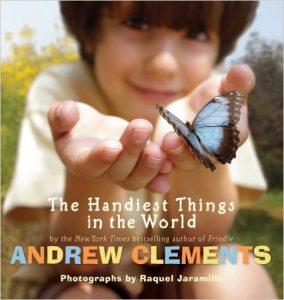
All who work with little ones deserve a big hand, so consider this post a “high five” from me to you as you start the school year!
Read More“Rah, Rah, Radishes” and Go, STEM!
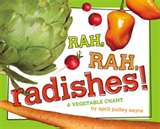 Happy May, everyone! I had the pleasure of speaking at an early education conference where our theme was literacy and science. I brought stacks of books that tie into STEM (Science, Technology, Engineering, Mathematics) or STEAM (add Art) to share. Rather than just lecture all day, I led a session of “speed-dating” books: we’d spend a few minutes skimming a book and brainstorming ways to use it with students, share our ideas with the group, and pass the book along. This way, we had time to get our hands on over a dozen books and walk away with practical classroom applications. I was so inspired by the fantastic ideas the teachers generated! Here are a few ideas we came up with after reading Rah,Rah, Radishes! A Vegetable Chant by April Pulley Sayre:
Happy May, everyone! I had the pleasure of speaking at an early education conference where our theme was literacy and science. I brought stacks of books that tie into STEM (Science, Technology, Engineering, Mathematics) or STEAM (add Art) to share. Rather than just lecture all day, I led a session of “speed-dating” books: we’d spend a few minutes skimming a book and brainstorming ways to use it with students, share our ideas with the group, and pass the book along. This way, we had time to get our hands on over a dozen books and walk away with practical classroom applications. I was so inspired by the fantastic ideas the teachers generated! Here are a few ideas we came up with after reading Rah,Rah, Radishes! A Vegetable Chant by April Pulley Sayre:
Bring in vegetables found in the book. Sort the vegetables by color and by size.
Classify and sort vegetables by the parts we eat: root vegetables, leaves, etc. Read Tops and Bottoms by Janet Stevens as a tie-in text and talk about which vegetables would be “tops” or “bottoms” according to Hare.
Predict which vegetables will sink or float. Test predictions in a tub of water. Wash the vegetables and talk about textures.
Use the vegetables to make prints.
Compare and contrast with fruits.
Weigh and measure the vegetables. Use a vegetable as a measuring tool.
Take photos of vegetables and label them. Reread the book and have students hold up the corresponding photos.
Make a chart or a Venn diagram with the terms “raw” and “cooked”. Try some vegetables both ways and chart our preferences.
See what other vegetables besides potatoes can be delicious mashed (great for little ones to do the mashing!)
Bring in potatoes with “eyes” sprouting and bring in vegetable seeds. Compare seeds and sprouts, then plant!
Make an edible collage with vegetables.
Practice patterning skills like ABAB, etc. with bite-size veggies and eat when done.
Plan a field trip to a farmer’s market or invite a farmer to come to the classroom for more vegetable experiences.
If you’re interested in the list of science books I shared, please email me at kristenremenar AT gmail DOT com. If you like Rah, Rah, Radishes! A Vegetable Chant, be sure to check out Go, Go, Grapes! A Fruit Chant and Let’s Go Nuts! Seeds We Eat also by April Pulley Sayre. Hooray for early science!
Read MoreHere Come the Humpbacks!
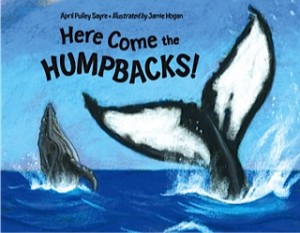 Happy March, everyone! This month I’m sharing a terrific informational picture book about humpback whales and a fabulous, free activity guide that will have your students up and moving as they process information. For those Nature Smart students who’re fighting the winter blahs, this kind of reading will be especially meaningful.
Happy March, everyone! This month I’m sharing a terrific informational picture book about humpback whales and a fabulous, free activity guide that will have your students up and moving as they process information. For those Nature Smart students who’re fighting the winter blahs, this kind of reading will be especially meaningful.
Here Come the Humpbacks! written by April Pulley Sayre and illustrated by Jamie Hogan is a nonfiction book detailing the migration of a humpback whale calf. Sayre gives us all the excitement of the treacherous journey that spans over 1,500 miles and doesn’t skimp on rich vocabulary or solid information.
After reading the book, your students can review what they’ve learned and “act out” the migration of a humpback. (Go, Key Ideas & Details!) Curious City has a wonderful, free humpback migration game you can download with step-by-step instructions and printables for 10 stations for students to visit. To add another layer of fun, go to YouTube and let kids hear the sounds that humpback whales make. (For more information about Curious City and its free children’s book engagement materials as well as book giveaways, please visit: curiouscitydpw.com. You’ll thank me later.)
I’ll be in New Jersey in April giving a seminar on early literacy skills for preschoolers and kindergartners. Please keep your fingers crossed that we’ll be enjoying tulip blossoms and not ice storms!
For more information about the author, please visit: aprilsayre.com.
For more information about the illustrator, please visit: jamiehogan.com
Read More
Frank Was a Monster Who Wanted to Dance
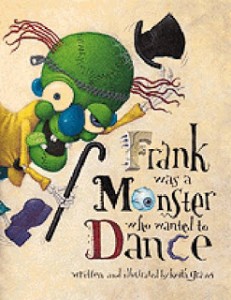 Here’s a treat for you this Halloween: a rhyming picture book that will delight your little monsters while you hit the CCSS of Fluency and Phonics & Word Recognition.
Here’s a treat for you this Halloween: a rhyming picture book that will delight your little monsters while you hit the CCSS of Fluency and Phonics & Word Recognition.
Frank was a Monster Who Wanted to Dance by Keith Graves is simple, spooky, silly fun. Frank’s dancing delights the audience until his body parts start to come loose, but even a cold shoulder from the crowd (see what I did there?) can’t diminish Franks’s love of performing.
There are plenty of simple rhymes for early elementary students to catch (“ants in his pants”, etc.) and I love that students can listen to them while they enjoy this story on TumbleBooks. Many school, public, and state libraries have subscriptions to this great website where kids can hear books read aloud. TumbleBooks has picture books, chapter books, fiction and nonfiction, all kinds of titles to help students build fluency. An extra bonus: TumbleBooks also has a section of lesson plans for teachers, including a K-2 lesson plan for Frank was a Monster Who Wanted to Dance!
So read aloud this book to your class, or log into TumbleBooks and project it so the entire class can enjoy it. If your little wigglers are anything like mine, they’ll want to move their bodies like Frank did, so on repeated readings, encourage listeners to act out the text. Kids can mime brains flopping out, arms falling out of sleeves, etc. For Halloween, or for anytime your mini-monsters need an active read-aloud, this book does the trick.
For more about the author/illustrator, please visit: keithgravesart.com.
Read More



